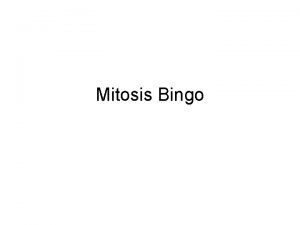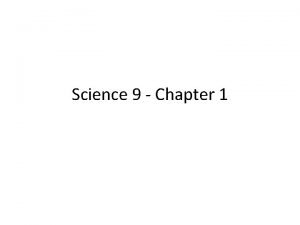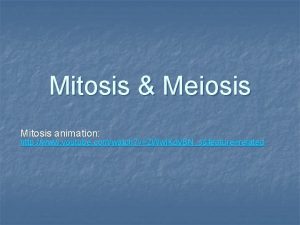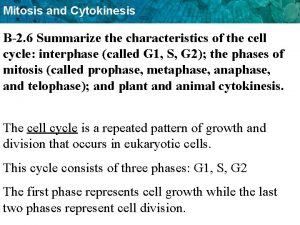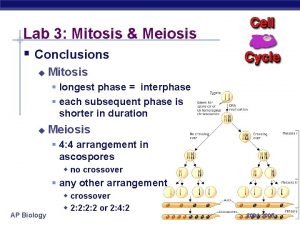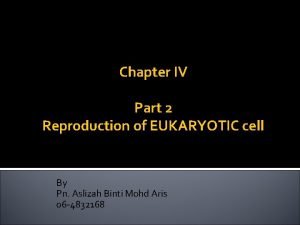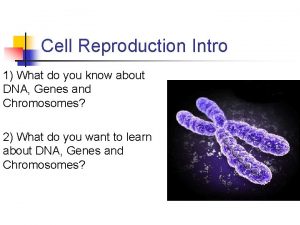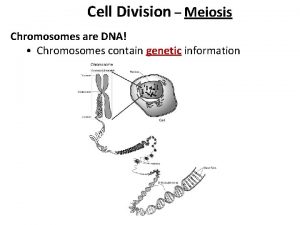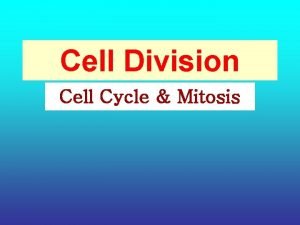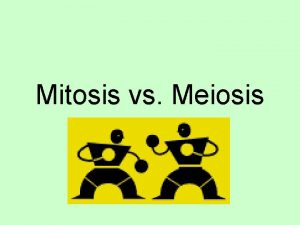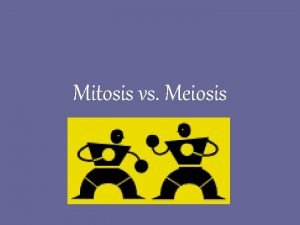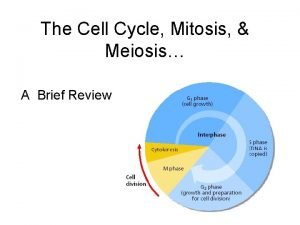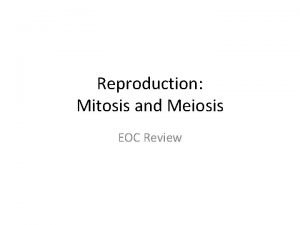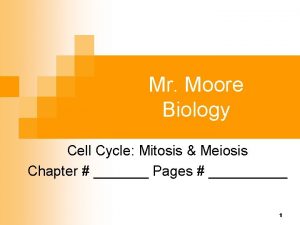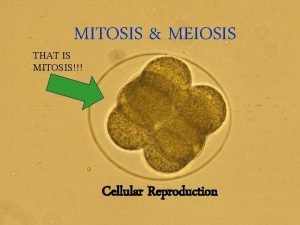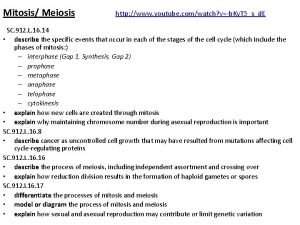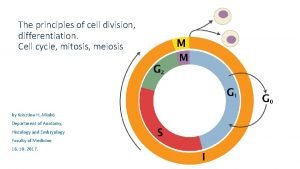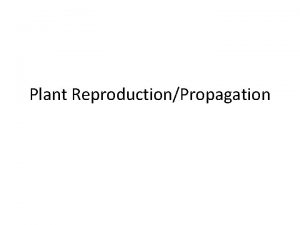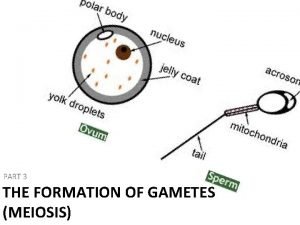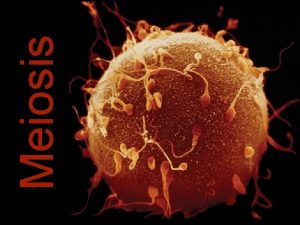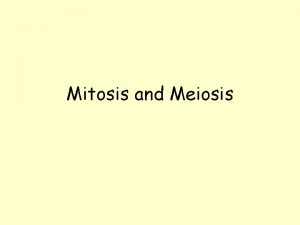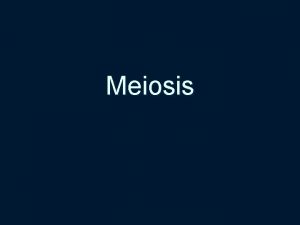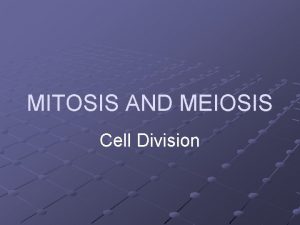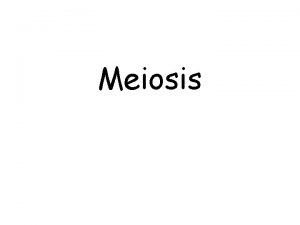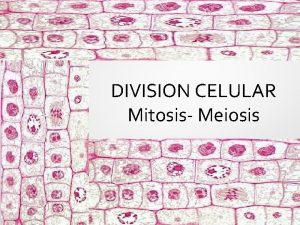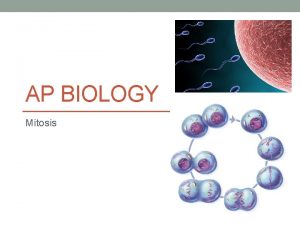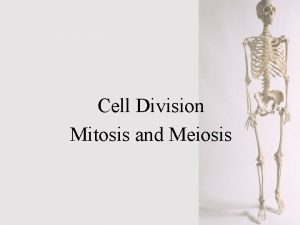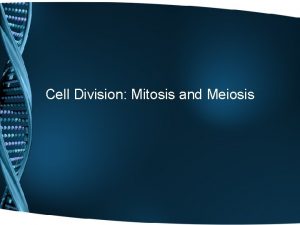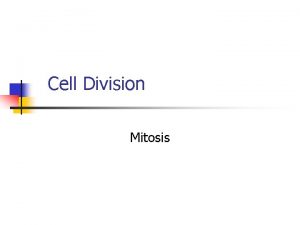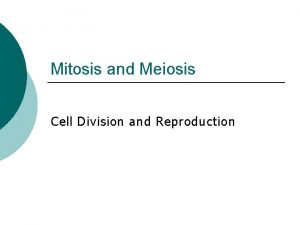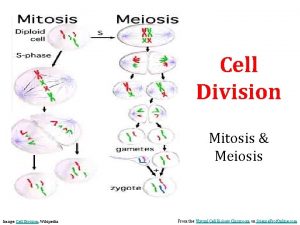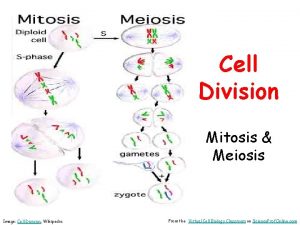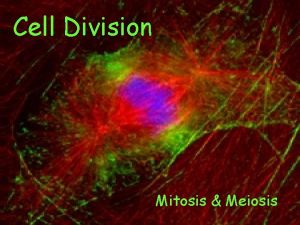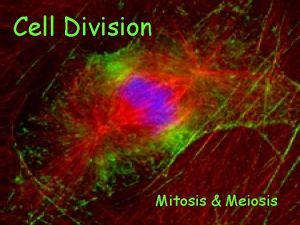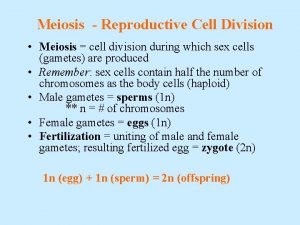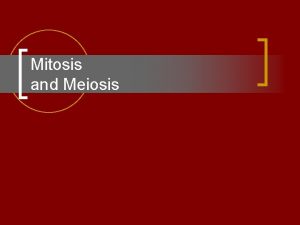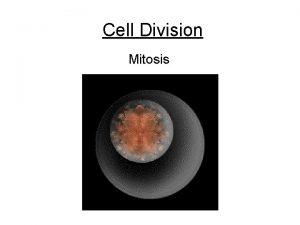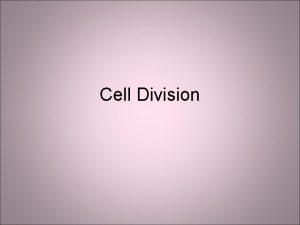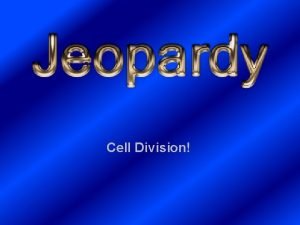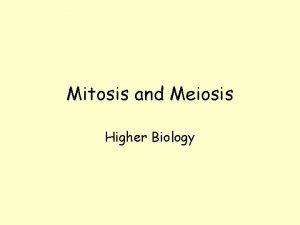Unit 6 Cell Division Mitosis and Meiosis Cells










































- Slides: 42

Unit 6 Cell Division Mitosis and Meiosis

Cells Life Span

Cell Cycle • Chemical messangers called hormones send signals to cells to prepare for division when it is needed.


Cell Division • A complex series of changes in the nucleus of a cell that leads to the production of two new cells. • The new cells are called daughter cells.

Why do cell divide? ? • DNA overload- The cell’s DNA would no longer be able to serve the increasing needs of the growing cell. • Exchange of Materials -If cells grow too large, its more difficult to get rid of waste and take in nutrients.


Why do cells divide? • Growth- Humans start off as one cell by the time they are adults they have over 10 trillion cells. • Repair- tissue damage • Reproduction – Asexual or Sexual

What is inside of the Nucleus? • Chromosomes are threadlike structures that contain genetic information that is passed on from one generation of cells to the next. • Chromosomes are made up of DNA • Chromosomes are only visible during cell division. Otherwise genetic information is known as chromatin.

Chromatin

Chromosomes

Parts of the chromosome • Centromere - the part of a chromosome that links sister chromatids • Chromatid - one copy of a duplicated chromosome, which is generally joined to the other copy by a single centromere. • Gene segment – segment of gene that codes for a trait

Phases of Cell Division • INTERPHASE (G 1, S, G 2) – growth and preparation, replication of DNA • Mitosis (M) - involves a complex series of changes in the nuclei of body cells that produce identical daughter cells


Stages of Mitosis Phase

Mitosis Phases • Prophase – Nuclear Membrane becomes invisible and chromosomes condense • Metaphase – Chromosomes line up in the middle • Anaphase – Chromosomes are pulled apart by spindle fibers that attach at the centromere • Telophase – Cell plate forms (plant only), cell membrane pinches in and cytokinesis occurs.

During Telophase - Cytokinesis • Dividing of the cytoplasm and the creation of two daughter cells during Telophase



The Cell Cycle and Cancer

Factors regulating cell cycle There are several factors that regulate the cell cycle and assure a cell divides correctly. 1. Before a cell divides, the DNA is checked to make sure it has replicated correctly. (If DNA does not copy itself correctly, a gene mutation occurs. )

2. Chemical Signals tell a cell when to start and stop dividing.

3. Neighboring cells communicate with dividing cells to regulate their growth also.

What is Cancer? Cancer is a disease of the cell cycle. Some of the body’s cells divide uncontrollably and tumors form.

While normal cells will stop dividing if there is a mutation in the DNA, cancer cells will continue to divide with mutation.

Tumors in Liver

SUMMARY Normal Cell Division Cancer Cells 1. DNA is replicated properly. 2. Chemical signals start and stop the cell cycle. 3. Cells communicate with each other so they don’t become overcrowded. 1. Mutations occur in the DNA when it is replicated. 2. Chemical signals that start and stop the cell cycle are ignored. 3. Cells do not communicate with each other and tumors form.

Causes that disrupt the cell cycle • • Smoking tobacco Radiation exposure Viral infection – HPV Chemicals

Estimated Cancer Deaths in the US in 2013

Treating Cancers Cancer treatments include drugs that can stop cancer cells from dividing.

MEIOSIS

Organisms that reproduce Sexually are made up of two different types of cells. 1. Somatic Cells are “body” cells and contain the normal number of chromosomes …. called the “Diploid” number (the symbol is 2 n). Examples would be … skin cells, brain cells, etc. (Mitosis Cell Division) 2. Gametes are the “sex” cells and contain only ½ the normal number of chromosomes…. called the “Haploid” number (the symbol is n)…. . Sperm cells and ova are gametes. (Meiosis Cell Division)

Meiosis is the process by which ”gametes” (sex cells) , with half the number of chromosomes, are produced. During Meiosis diploid cells are reduced to haploid cells Diploid (2 n) Haploid (n) If Meiosis did not occur the chromosome number in each new generation would double…. The offspring would die.

Meiosis Cell Division • Cell division that forms of sex cells (gametes) • Egg cell and Sperm cell (gametes) • 4 daughter cells are made with each having half the number of chromosomes as parent cell (n) Haploid • Reduction of chromosomes • Cells are NOT identical to parent

Stages of Meiosis

Karyotype - a photograph of a full set of chromosomes “Sex Chromosomes” ……. the 23 rd set This person has 2 “X” chromosomes… and is a female. 23

Homologous Chromosomes • Pair of chromosomes (maternal and paternal) paternal that are similar in shape and size. • Homologous pairs (tetrads) carry genes controlling the same inherited traits. • Each locus (position of a gene) is in the same position on homologues. • Humans have 23 pairs of homologous chromosomes. 22 pairs of autosomes 1 pair of sex chromosomes

Homologous Chromosomes (because a homologous pair consists of 4 chromatids it is called a “Tetrad”) eye color locus hair color locus Paternal Maternal

Crossing Over creates variation (diversity) in the offspring’s traits. Tetrad nonsister chromatids variation

Factors that Cause Genetic Variation in Offspring • Crossing Over • Genetic Mutation of DNA

Question: • A cell containing 20 chromosomes (diploid) at the beginning of meiosis would, at its completion, produce cells containing how many chromosomes? chromosomes

Answer: • 10 chromosomes (haploid)
 Mitosis meiosis
Mitosis meiosis Cell division mitosis and meiosis
Cell division mitosis and meiosis Mitosis
Mitosis Mitosis cell division
Mitosis cell division Events of the cell cycle
Events of the cell cycle Cell cycle and cell division
Cell cycle and cell division Cell cycle mitosis
Cell cycle mitosis Mitosis and meiosis venn diagram
Mitosis and meiosis venn diagram Purpose of mitosis and meiosis
Purpose of mitosis and meiosis Whats the difference between mitosis and meiosis
Whats the difference between mitosis and meiosis Kesler science the lab room answer key
Kesler science the lab room answer key Gametes vs somatic cells
Gametes vs somatic cells Youtube
Youtube Summarize mitosis
Summarize mitosis Meaning of diploid and haploid
Meaning of diploid and haploid Respirometer
Respirometer Meiosis flipbook
Meiosis flipbook Chromosomes in organisms
Chromosomes in organisms Chromosome sets (=n) in mitosis and meiosis
Chromosome sets (=n) in mitosis and meiosis Characteristics of mitosis and meiosis
Characteristics of mitosis and meiosis Number of chromosomes in meiosis
Number of chromosomes in meiosis Anaphase meaning
Anaphase meaning Difference between meiosis 1 and meiosis 2
Difference between meiosis 1 and meiosis 2 Anapjase
Anapjase Chromosomes number is maintained mitosis or meiosis
Chromosomes number is maintained mitosis or meiosis Mitosis vs meiosis double bubble compare and contrast
Mitosis vs meiosis double bubble compare and contrast Mitosis and meiosis reflection
Mitosis and meiosis reflection Mitosis vs meiosis animation
Mitosis vs meiosis animation Meiosis and mitosis animation
Meiosis and mitosis animation Mitosis and meiosis
Mitosis and meiosis Comparison of mitosis and meiosis table
Comparison of mitosis and meiosis table Mitosis and meiosis
Mitosis and meiosis Mitosis and meiosis
Mitosis and meiosis Independent assortment of chromosome
Independent assortment of chromosome Difference of sexual and asexual reproduction
Difference of sexual and asexual reproduction Diploten
Diploten Learning objectives of reproduction in plants
Learning objectives of reproduction in plants Crossing over occurs during:
Crossing over occurs during: Phases of mitosis in order
Phases of mitosis in order Meiosis jeopardy
Meiosis jeopardy Mitosis and meiosis differences
Mitosis and meiosis differences Cell having 6 chromosomes that undergoes meiosis
Cell having 6 chromosomes that undergoes meiosis Concept map mitosis and meiosis
Concept map mitosis and meiosis



